Anomalies of Color Vision
1/97
There's no tags or description
Looks like no tags are added yet.
Name | Mastery | Learn | Test | Matching | Spaced |
|---|
No study sessions yet.
98 Terms
what is tritanopia?
- missing cyanolabe
what is deuteranopia?
- missing chlorolabe
what is protanopia?
- missing erythrolabe
what do the other photopigments do for missing photopigment in dichromacy?
- missing photopigment is replaced by a remaining photopigment
what do the remaining photopigments do for deuteranopia?
- in the case of deuteranopia, chlorolabe is replaced by erythrolabe
what do the remaining photopigments do for protanopia?
- in protanopia, erythrolabe is replaced by chlorolabe
What is anomalous trichromacy?
- In anomalous trichromacy three photopigments are present, but the absorption spectrum of one of these photo pigments is displaced to an abnormal position
what happens to the photopigments in deuteranomalous trichromacy?
- n the condition of deuteranomalous trichromacy, the chlorolabe spectrum is displaced toward longer wavelengths
what happens to the photopigments in protanomalous trichromacy?
- In the condition protanomalous trichromacy the erythrolabe spectrum is displaced toward shorter wavelengths
will the color vision anomaly be more or less severe with great displacement of the photopigment in anomalous trichromacy?
- greater
what colors do individuals with protan and deutan vision confuse?
- red and green
what colors do individuals with tritan vision confuse?
- blue and yellow
what type of color vision anomaly is usually inherited?
- protan
- deutan
what type of color vision anomaly is usually acquired?
- tritan
how many peaks are there in the spectral sensitivity of individuals in deuteranopia?
- In deuteranopia, there are only two peaks, corresponding to the remaining two photopigments, cyanolabe and erythrolabe
how many peaks are there in the spectral sensitivity of individuals in protanopia?
- individuals with protanopia manifest two peaks, one for cyanolabe and one for chlorolabe.
where does the protanopic curve displaced in spectral sensitivity chart?
- substantially displaced toward shorter wavelengths
- these individuals may find it difficult to see certain red objects
where does the deutranopia curve displaced in spectral sensitivity chart?
- shows a very slight displacement toward longer wavelengths
what does greater dislocation of the protanopic luminance function suggest?
- suggests that L-cones play a greater role in generating the normal V(λ) function than do M-cones.
when is there a well-developed wavelength discrimination in individuals with protanopia and deuteranopia?
- For both protanopia and deuteranopia, there is relatively well-developed wavelength discrimination in the region of 490 nm
at what wavelength is there no ability to discriminate between stimuli on the basis of wavelength differences in protanopia and deuteranopia?
- at longer wavelengths—beyond approximately 545 nm—there is no ability to discriminate between stimuli on the basis of wavelength differences alone
where is there well-developed wavelength discrimination for tritanopia?
- there is well-developed wavelength discrimination at longer wavelength
where is there poor wavelength discrimination for tritanopia?
- poor wavelength discrimination in the region of 495 nm
why do individuals with deuteranopia and tritanopia have poor wavelength discrimination past 545 nm?
- Individuals with deuteranopia and protanopia have only one cone photopigment that absorbs beyond 545 nm, and thus manifest monochromatic color matching in this region of the spectrum
- They are able to discriminate among stimuli that are longer than 545 nm if these stimuli differ in luminance.
do the confusion lines for deuteranopia, protanopia, and tritanopia originate from the same or different copunctal point?
- different
- All colors falling along a confusion line are indistinguishable
what wavelength does deuternopic function intersect?
- intersects the abscissa at approximately 498 nm
what wavelength does protanopic function intersect?
- the protanopic function intersects it at 492 nm.
what are neutral points?
- 498 and 492
- particular wavelengths appear white—they are totally desaturated, and are referred to as neutral points
do individuals with anomalous trichromacy have neutral points?
- Individuals with anomalous trichromacy do not manifest neutral points, they display abnormal saturation perception
what is the least saturated wavelength in deuteranomalous trichromacy?
- 498nm
what is the least saturated wavelength in protanomalous trichromacy?
- 492
how are red-green anomalies inherited?
- transmitted in an X-linked recessive fashion
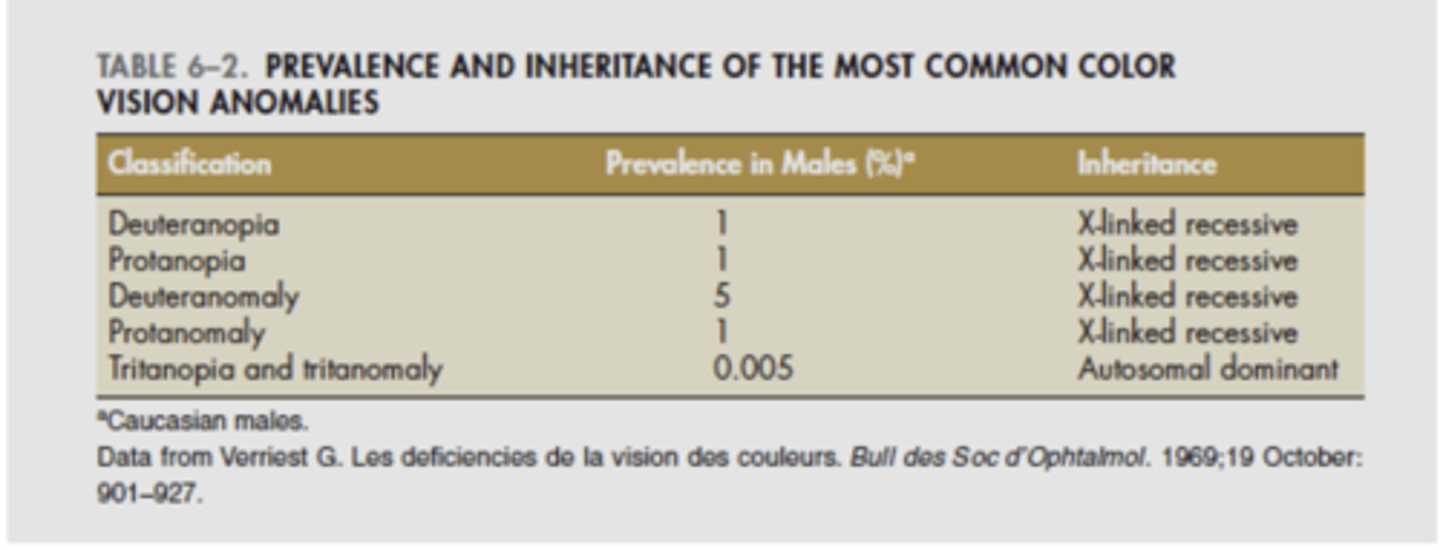
are red-green anomalies more common in men or women?
- They are considerably more common in men than women, with prevalences of approximately 8.0% and 0.4%, respectively
what must a female be in order to express color vision anomaly?
- a female must be homozygous
who does a boy always receive the defective gene for color vision from?
- receives the defective gene from the mother
how are the genes for the M and L cone photopigments arranged?
- The highly homologous genes for the M- and L-cone photopigment opsins are positioned on the X chromosome in a head-to-tail tandem array.
what does the arrangement of M and L genes suggest?
- erroneous crossover of genetic information could occur when the pair of X chromosomes aligns and exchanges genetic information during meiosis (i.e., unequal homologous recombination).
- For instance, the gene coding for the M-cone opsin could erroneously align with the gene coding for the L-cone opsin, leading to an unequal exchange of genetic information
what is inherited color vision often secondary to?
- secondary to disease or drug toxicity, and can be an important diagnostic tool
what is cyanolabe?
- The pigment in retinal cones that is more sensitive to the blue portion of the spectrum
what are the two general categories for color vision anomalies?
- dichromacy
- anomalous trichromacy
what is dichromacy?
- missing one of the three retinal photopigments
what percentage of the population has anomalous color vision?
- 4.5%
are inherited color anomalies progressive?
- non-progressive and pose no threat to vision
what are color anomalies that are not inherited called?
- acquired
are acquired or inherited colors anomalies more common?
- inherited
what is chlorolabe?
- The pigment in retinal cones that is more sensitive to the green portion of the spectrum
what is erythrolabe?
- the pigment in retinal cones that is more sensitive to the red portion of the spectrum
where are M and L cones normally aligned during meiosis?
- During meiosis, the M-cone and L-cone photopigment genes (green and red arrows, respectively) on one chromosome normally align the M-cone and L-cone photopigment genes on the paired chromosome
what happens genetically that causes dichromacy?
- Dichromacy could result when the M-cone photopigment gene erroneously aligns with the highly homologous L-cone photopigment gene, leading to the intergenetic crossover of the M-cone photopigment gene.
-As a result, one chromosome has no M-cone photopigment genes; the offspring who inherit this chromosome may manifest deuteranopia.
- The paired chromosome has two copies of the M-cone photopigment gene and one copy of the L-cone photopigment gene; the offspring who inherit this chromosome will have normal color vision.
what does intragenetic crossover result in?
- intragenetic crossover results in hybrid genes (combination green-red arrows).
- Depending on the specific nature of the crossover, a hybrid gene may result in a normal photopigment, the loss of a photopigment (dichromacy), or a photopigment with an absorption spectra that is displaced from its normal location (anomalous trichromacy)
what occurs when M-cone opsin crosses over during meiosis?
- one of the X chromosomes does not have the gene coding for the M-cone opsin, and the offspring inheriting this chromosome may manifest deuteranopia.
- The other chromosome has multiple copies of the gene coding for the M-cone opsin, offspring inheriting this chromosome will have normal color vision
- Depending on the specific nature of the intragenetic crossover, the resultant hybrid gene leads to a normal photopigment, the non-expression of the photopigment (dichromacy), or an aberrant photopigment, the latter may be the molecular basis of anomalous trichromacy
what may a hybrid gene that differs substantially from the normal gene result in?
- severe anomalous trichromacy
What is Kollner's rule?
- outer retinal disease and media changes result in blue-yellow color vision anomalies, whereas disease of the inner retina, optic nerve, visual pathways, and visual cortex results in red-green anomalies
what is non-selective loss?
- A patient may manifest both a blue-yellow and red-green anomaly simultaneously, a condition sometimes referred to as a nonselective loss
what condition may be associated with non-selective loss?
- Köllner's rule predicts red-green anomalies in optic neuritis, this conditions may be associated with nonselective loss

what is achromatiopsias?
- rare conditions where the patient manifests monochromatic (or nearly monochromatic) vision
what is the most common achromatopsia?
- The most common is autosomal recessive (AR) achromatopsia
what is complete AR achromatopsia?
- where only rods are present
what is incomplete AR achromatopsia?
- where there is residual L/M cone function, have been reported
what are signs of achromatopsias?
- no or very poor color discrimination
- nystagmus
- photophobia
- VA of 20/200
what is X-linked achromatopsia?
- sometimes called blue or s-cone monochromacy
- contains only rods and s-cones
what are chromatopsias?
- are not true color abnormalities bc they do not typically produce a decreased ability to discriminate colors
- they represent a distortion of color vision, similar to looking through a colored filter
- pts report that objects have a colored tinge or halo
what surgery may cause chromatopsias?
- may follow cataract extraction
why may cataract extraction cause chromatopsias?
- Removal of the cataract exposes the retina to considerably more blue light than it has experienced in some time, resulting in the perception of blueness(cyanopsia)
what may produce xanthopsia (yellow vision)?
- digitialis
- fluorescein, used in fluorescein angiography
what is the most common/standard for color vision test?
- Pseudoisochromatic Plate Tests
- Vanishing plates are the most common; they consist of a figure that must be distinguished from the background.
why do patients with color anomalies have difficulty seeing Pseudoisochromatic Plate Tests?
- because the colors that make up the figure and those that constitute the background all fall on a common dichromatic confusion line
what shape may not be visible to deuteranopia?
- circle
what shape may not be visible to protanopia?
- triangle
what shape may not be visible in tritanomaly?
- X
Can Ishihara tell R/G and B/Y defect?
NO! only R/G
and it cannot tell the difference between dichromats and anomalous trichromats
what plate test can test for B/Y defect?
- HRR and SP2 books can test for blue-yellow
what is Farnsworth Dichotomous Test?
- referred to as an arrangement test.
• Allow the differentiation of protan, deutan, and tritan anomalies
• Does not allow the differentiation of dichromacy from anomalous trichromacy
• Some anomalous trichromacy may pass this test
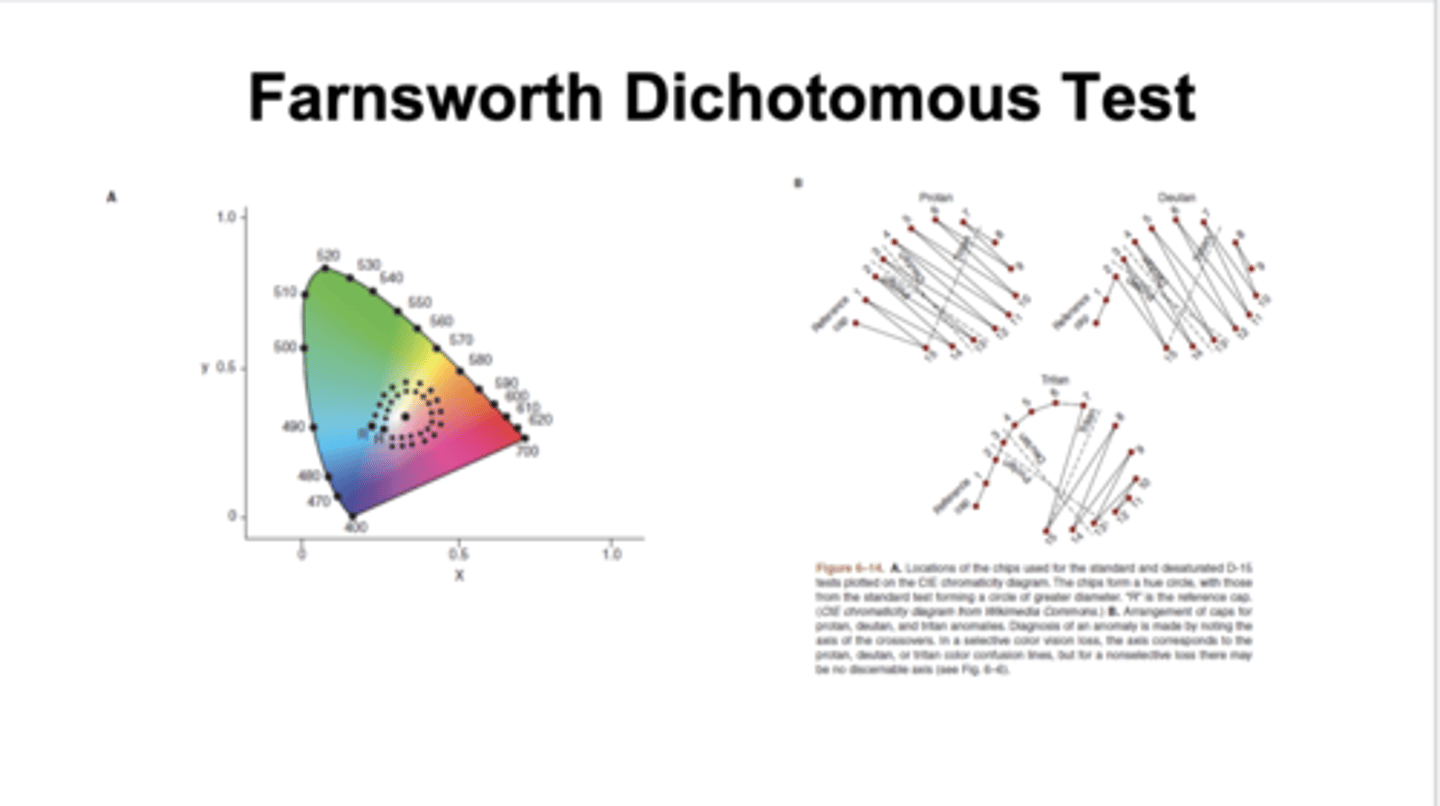
what is desaturated Lanthony D-15 Test?
- In the desaturated Lanthony panel D-15 test, the chips are less saturated than those in the standard D-15 test
• The task is more difficult, it detects anomalies that would be missed by the standard D-15 test
what is the Destaturated Lanthony D-15 Test for?
- It may be especially useful in the detection of subtle acquired losses that occur in certain eye diseases, such as glaucoma
What is the Farnsworth-Munsell 100 hue test?
- The 100-hue test consists of only 85 color chips.
• These chips, which form a hue circle in the CIE diagram, are divided among four separate trays.
• The patient arranges, according to color, the chips contained within each tray.
• The test is graded by plotting the data on a scoring sheet and calculating a total error score.
• When the total error score is greater than the norms provided by the manufacturer, a diagnosis of a color anomaly is made
what is Farnsworth-Munsell 100-Hue Test used for?
- Used to identify protan, deutan or tritan loss
what is bad about the Farnsworth-Munsell 100-Hue Test?
• Does not distinguish dichromacy from anomalous trichromacy
• Time consuming test
what is the Rabin Contrast Test?
- Allows assessment of the functionality of each of the three types of cones, which is administered using a computer.
- Each column contains optotypes that are detectable based on contrast as defined for only one of the three cones.
• As the patient reads down a column, the cone contrast decreases until a threshold is reached
what is an important measurement that is taken with Rabin Contrast Test?
- Importantly, this test allows a cone threshold to be obtained for each of the three different cones.
- The current computer-based version of the CCT uses an interactive staircase procedure with randomized letter presentation to determine each cone threshold.
what test allows for a much more refined quantitative measurement?
- Rabin Cone Contrast Test
- This provides an important opportunity to track the progression of an acquired color vision deficiency to determine if it remains stable, deteriorates, or improves
what disease is CTT affected?
- The CCT is affected in glaucoma and has the potential to play an important role in assessing color vision in clinical practice
what is the Nagel Anomaloscope?
- the only clinical instrument that can provide a complete diagnosis of red-green color vision anomaly,
can the Nagel Anomaloscope differentiate between dichromacy and anomalous trichromacy?
- yes
how does the Nagel Anomalscope work?
- Mixture scale settings between 0 and 73 represent various combinations of 546 and 670 nm.
• A test knob scale setting of 0 represents very dim yellow,where as a scale reading of 87 represents bright yellow
• An important feature of the mixture field is that its luminance, as measured for normal trichromacy, does not change.
• Whether the mixture field consists of pure 546 nm, pure 670nm, or any combination there of, the luminance is the same
If the mixture field is set to pure 546 nm, can a patient with red-green dichromacy adjust the test field radiance so this field matches exactly the mixture field?
- yes both appear identical
If the mixture field is set subsequently at pure 670 nm, can this patient with dichromacy nowadjust the radiance of the test field so that the two fields appear identical?
- yes both appear identical
what is a person with dichromacy able to do no matter what combination of 546nm and 670nm is present in the mixture field?
- a person with dichromatic vision is able to adjust the radiance of the 590-nm test field such that it matches the mixture field
- Red-green dichromacy: @545nm to 700nm: one wavelength can be matched to other if the relative radiances are adjusted appropriately
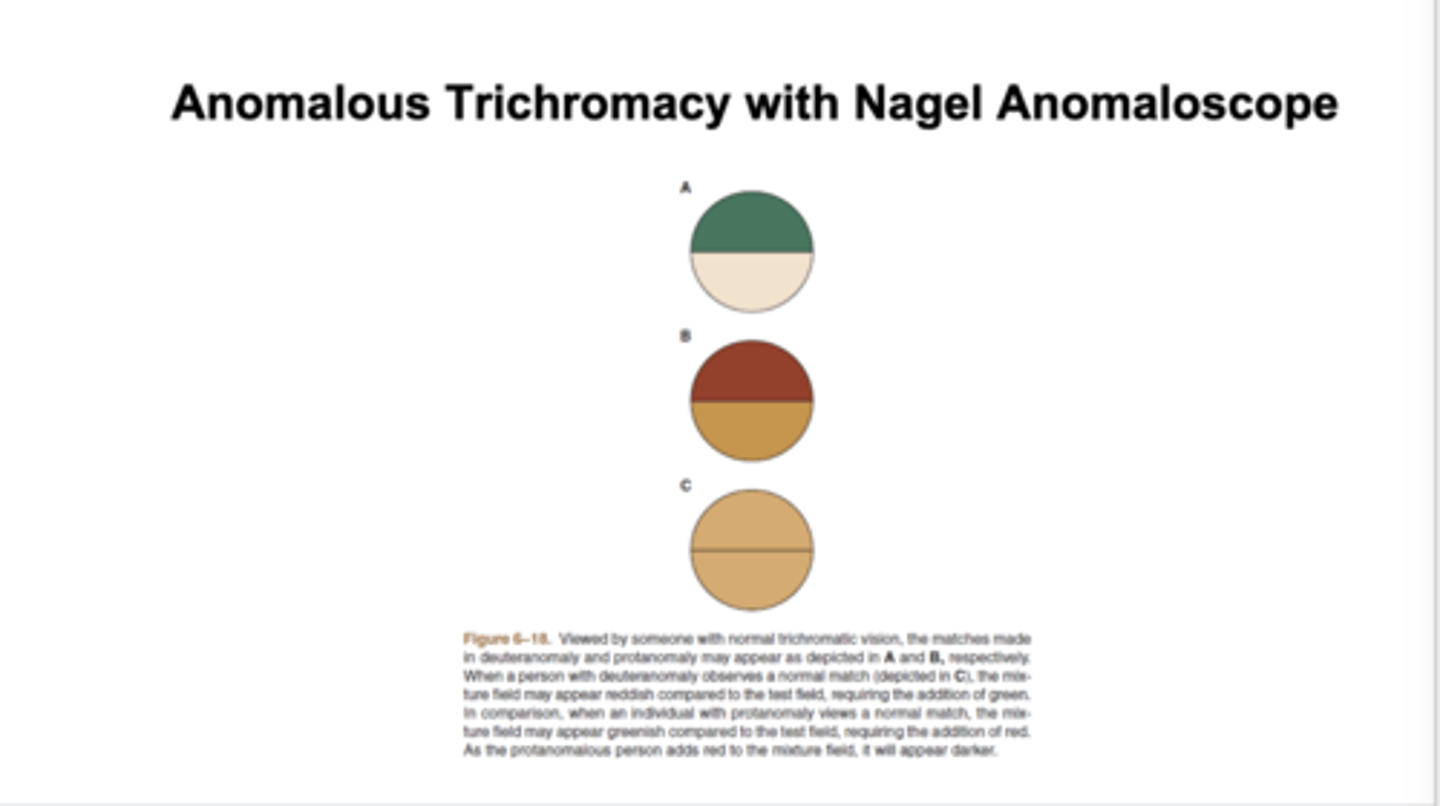
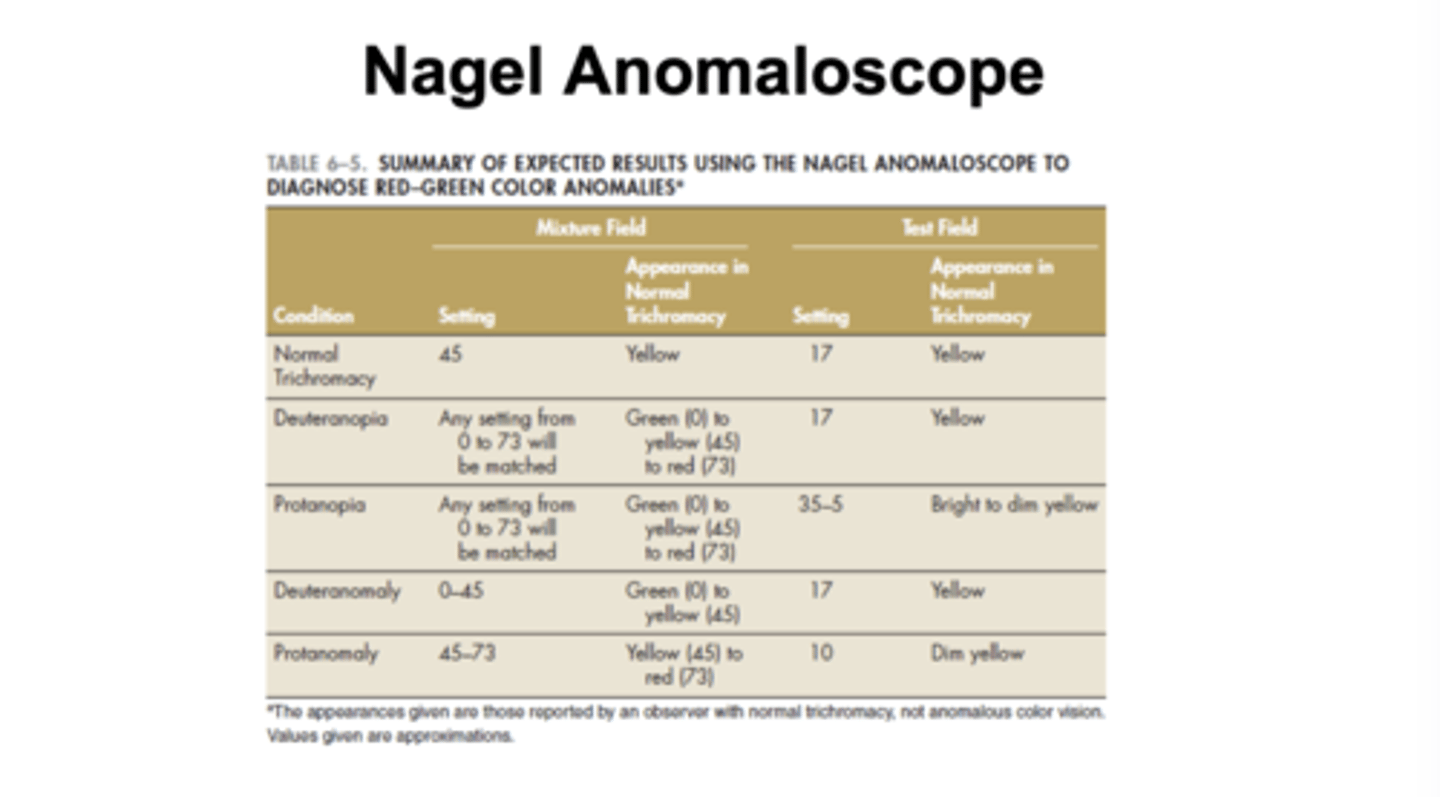
how are colored filters used to treat color anomalies?
- A red contact lens, worn on one eye, is sometimes used with the goal of improving color discrimination, this contact lens is prescribed for dichromacy or anomalous trichromacy
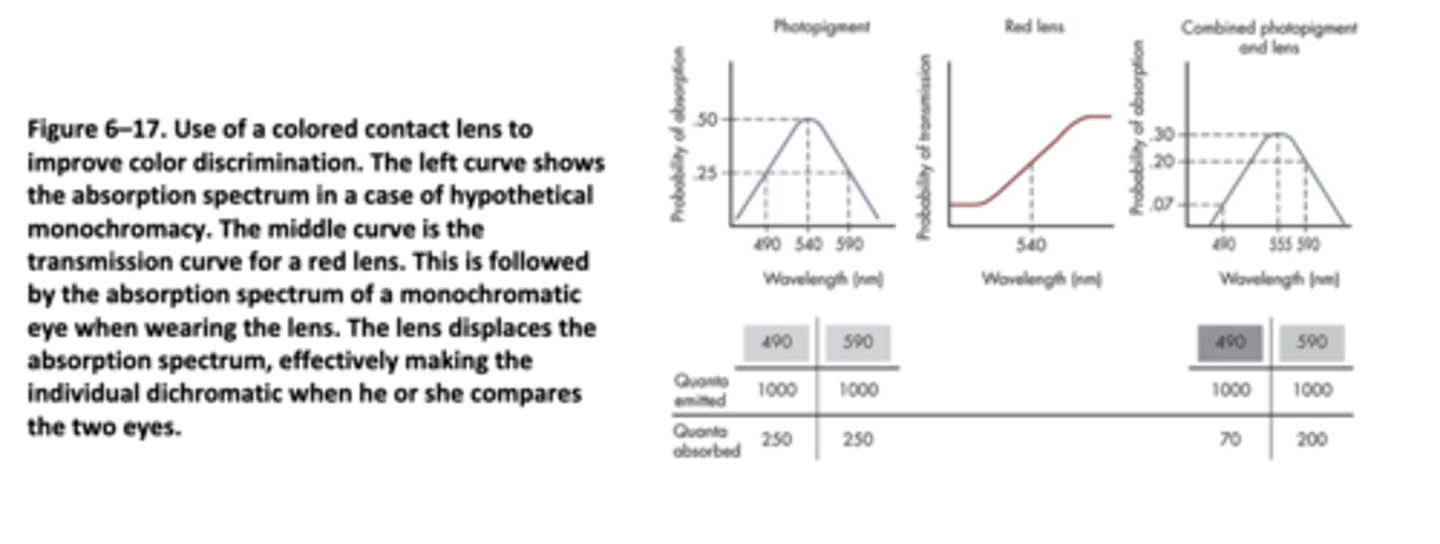
how is gene therapy used to treat color anomalies?
- The replacement of defective genes in people with color deficiencies offers the promise to cure color blindness.
• Mancuso et al (2009) have demonstrated that adult dichromatic monkeys infected with a virus carrying the missing opsin gene manifest improved color vision.
• Although promising, further work is needed to determine the efficacy and safety of such an approach in humans.
what cone photopigment is more vulnerable to certain pathological processes?
- S-cone system is more vulnerable compared to M and L cone system
what is SWAP?
- Short-wavelength automated perimetry (SWAP) has been developed to assess S-system function in certain eye diseases, particularly glaucoma.
• The commonly used Humphrey visual field apparatus can be adapted for this function by replacing the standard white stimulus with a short-wavelength stimulus to maximize S-system sensitivity.
• To suppress the M- and L-cones, the background is yellow rather than the standard white